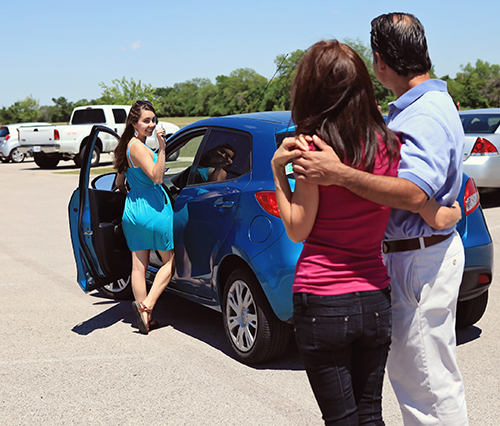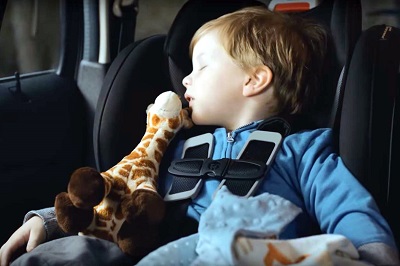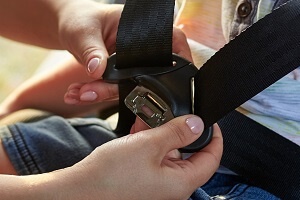Car crashes are a leading cause of death for children. In 2020, 1,093 children 14 and under were killed in motor vehicle crashes, according to Injury Facts. Properly securing children in car seats that meet federal motor vehicle safety standards goes a long way in keeping them safe. The National Safety Council believes child restraint systems should go beyond state requirements, because too often state laws are no match for the laws of physics.
Child Passenger Safety Week is recognized each year during the third week of September. Get everything you need to help raise awareness and prevent these tragedies here.
Living Proof
Brooke Ice owes her life to a properly fitted car seat. Her mother had her car seat checked just two weeks before a very serious collision. Brooke, a firefighter, now plans to become a certified car seat technician.
National Digital Car Seat Check Form
Data collection among certified child passenger safety technicians is essential to improving safety for children. Correct use of car seats, booster seats and seat belts is vital to preventing injuries and fatalities during vehicle crashes, and accurate and standardized information on car seat misuse is necessary to understand the scope of the problem.
Recognizing this need, NSC led a groundbreaking effort to develop a standardized National Digital Car Seat Check Form (NDCF) in partnership with Tennessee Tech University iCube, certified child passenger safety technicians, and with support from the National Highway Traffic Safety Administration and AAA Northern California, Nevada & Utah.
Information collected by the Check Form creates a database that can be used to improve car seat safety programs, influence car seat and vehicle design, and provide insight into the misuse of car seats, booster seats and seat belts. This standardized electronic form is available to certified child passenger safety technicians, program managers, state and regional child passenger safety coordinators, and vehicle and car seat manufacturers.
Data dashboards created by the NDCF are available to vehicle and car seat manufacturers to inform product design to address common misuse patterns. National data also can inform public education campaigns and identify geographic gaps in child passenger safety services to improve health equity. It is anticipated that the NDCF also will be incorporated as an industry standard in the 2024 update of the National Child Passenger Safety Technician Certification Training curriculum, the U.S. training program for technicians.
Unfortunately, there is no national requirement for documenting car seat checks. Policies to support NDCF use are needed at the local, state, regional and national levels. Lives can be saved and injuries prevented if NDCF is widely implemented.
National Child Passenger Safety Board
NSC has managed the National Child Passenger Safety Board since its inception in the late 1990s. Its mission is to save lives and prevent injuries by promoting child passenger safety through education, mentorship, engagement and innovation. Certified child passenger safety technicians and instructors work in the field to help families and caregivers safely transport children.
The Board provides input from their representative organizations and from the field to ensure the quality and integrity of the National Child Passenger Safety Technician Certification Training curriculum. The Board works with the National Highway Traffic Safety Administration, which developed the original curriculum and remains committed to providing regular updates to the curriculum, and Safe Kids Worldwide, which is responsible for the certification and re-certification processes. Learn more here.
Tips on Child Passenger Safety
● Read the NSC position statement on child restraints, which addresses child passenger safety among multiple modes of transportation
● Take advantage of car seat safety checks held nationwide during National Child Passenger Safety Week
● If you're pregnant, schedule a car seat installation with a certified child passenger safety technician before the child is born
● Children should ride in the back seat at least through age 12
● If your kids complain about wearing seat belts, don't negotiate; don't drive off until they buckle up
● Always be consistent and wear your seat belt; driver safety belt use strongly influences whether your child will buckle up
● All 50 states require child seats with specific criteria; here is a list of child passenger safety laws by state, but too often, state laws don't go far enough
● The life of a car seat typically ranges from six to 10 years; be sure to identify the expiration date set by the manufacturer of the seat being used
● Recalls for child seat manufacturers for the past 10 years can be found here
● Air bags can save the lives of older children and adults, but they can be fatal for young children when not seated correctly, particularly in the front seat; never place a rear-facing car seat in a front seat near an air bag
● Always read instructions provided by the vehicle and car seat manufacturers for properly securing children in all seating positions.
Kids and Hot Cars
Over the past 24 years, more than 900 children have died in all but three U. S. states, and deaths have occurred during every month of the year. NSC now offers a free Children in Hot Cars e-learning course to assist everyone in understanding this preventable cause of death and why children are at greater risk.
According to noheatstroke.org:
● 55% of children who have died were under 2 years of age
● 52% were forgotten by caregiver (505 children)
● 24% gained access on their own (237)
● 21% were knowingly left by caregiver (200)
● 1.8% were unknown (26)
Learn more about kids and hot cars.
Vehicle Crashes the No. 1 Killer of Teens
 Motor-vehicle crashes continue to be the No. 1 cause of death for U.S. teens. According to Injury Facts, 2,723 teens were killed in vehicle crashes in 2021.
Motor-vehicle crashes continue to be the No. 1 cause of death for U.S. teens. According to Injury Facts, 2,723 teens were killed in vehicle crashes in 2021.
Yes, these statistics are frightening. That's why teen driver safety is an NSC initiative. Learn why a teen's biggest threat is sitting on the driveway and what you can do to protect your child – from having them sign a safe-driving contract to signing up for the weekly Digital Driving Coach.
More Child Passenger Safety Resources
● Child Passenger Safety Board
● Child Safety - NHTSA
● Find a CPS Technician
● NoHeatStroke.org
● Special Needs Transportation
● Safe Travel for All Children (STAC)
● NSC Mobility Safety: Free Training and Resources


 Motor-vehicle crashes continue to be the No. 1 cause of death for U.S. teens. According to
Motor-vehicle crashes continue to be the No. 1 cause of death for U.S. teens. According to 


